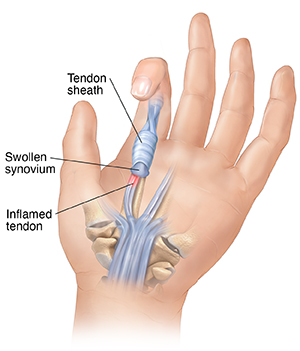Trigger finger is an inflammation of tissue inside your finger or thumb. It's also called tenosynovitis. Tendons are cordlike fibers that attach muscle to bone and allow you to bend the joints. They can become swollen. So does the synovium. This is a slick membrane that allows the tendons to move easily. This makes it hard to straighten the finger or thumb.
How to say it
tehn-oh-sin-oh-VI-tihs
Causes
Repeated use of a tool with strong gripping, such as a drill or wrench, can irritate and inflame the tendons and the synovium. It's also more common in certain medical conditions, such as rheumatoid arthritis, gout, and diabetes. But often the cause of trigger finger is unknown.
Inside your finger
Tendons connect muscles in your forearm to the bones in your fingers. The tendons in each finger are surrounded by a protective tendon sheath. This sheath is lined with synovium. The synovium makes a fluid that allows the tendons to slide easily when you bend and straighten the finger. If a tendon is irritated, it becomes inflamed.
When a tendon is inflamed
When a tendon is inflamed, it causes the lining of the tendon sheath to swell and thicken. Or the tendon itself may thicken. Then the sheath pinches the tendon. The tendon can then no longer slide easily inside the sheath. When you straighten your finger, the tendon sticks or “locks” as it tries to squeeze back through the sheath.
Symptoms
The first sign of trigger finger may be pain where the finger or thumb joins the palm. You may also notice some swelling. As the tendon becomes more inflamed, the finger may start to catch when you try to straighten or bend it. When the locked tendon releases, the finger jumps, as if you were releasing the trigger of a gun. This further irritates the tendon. It may set up a cycle of catching and swelling.


